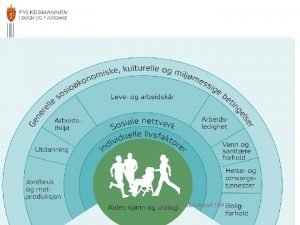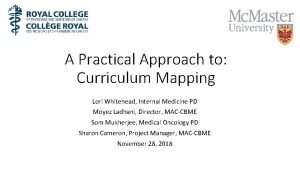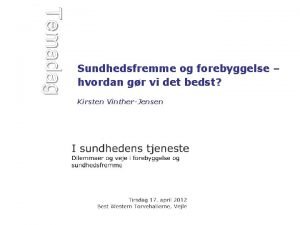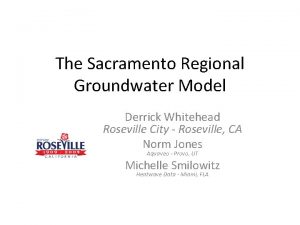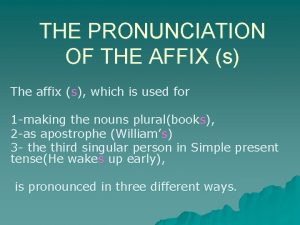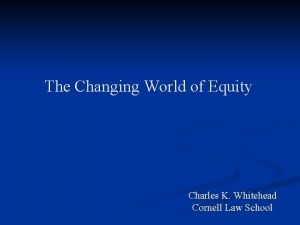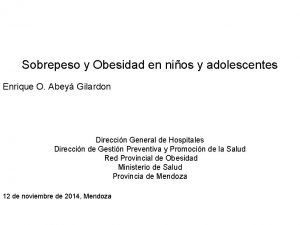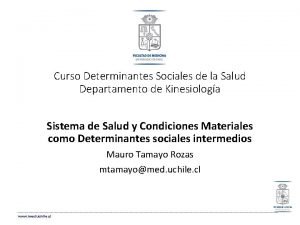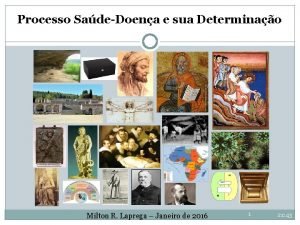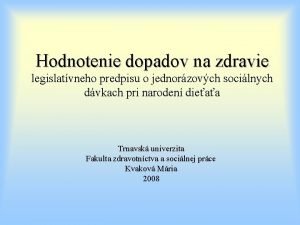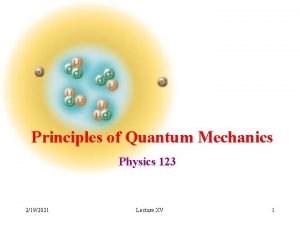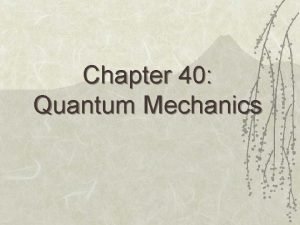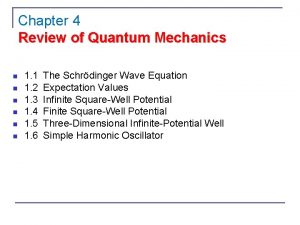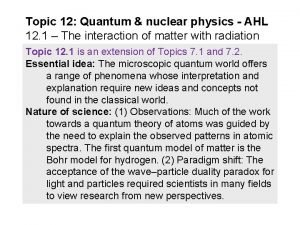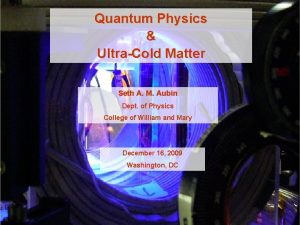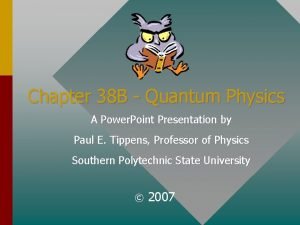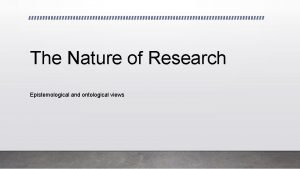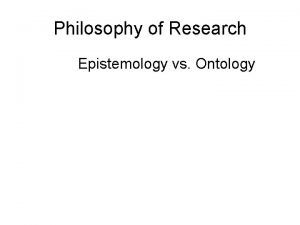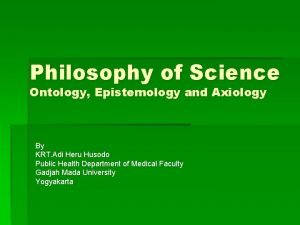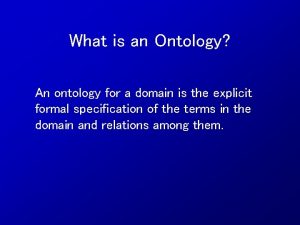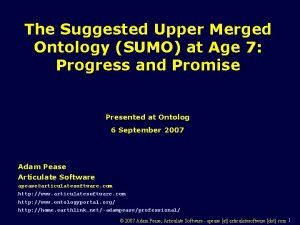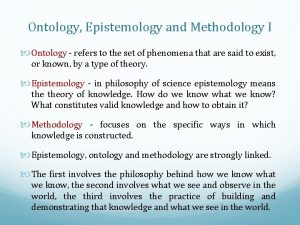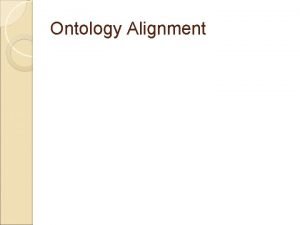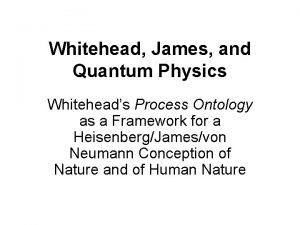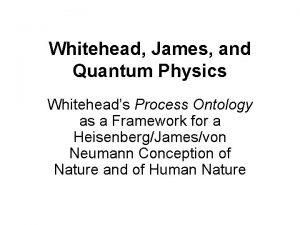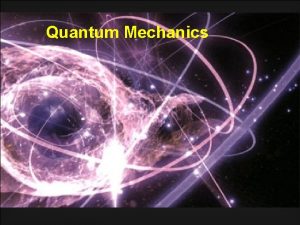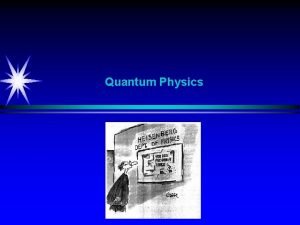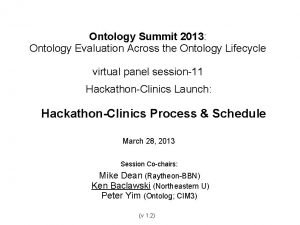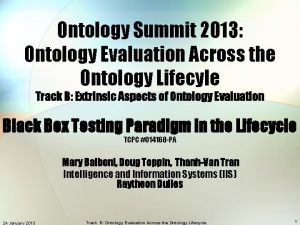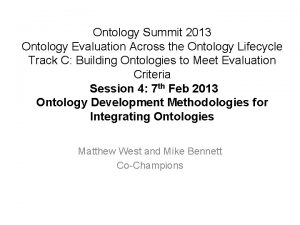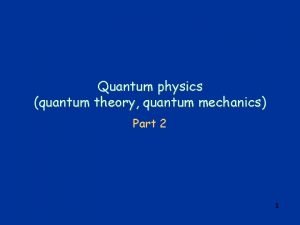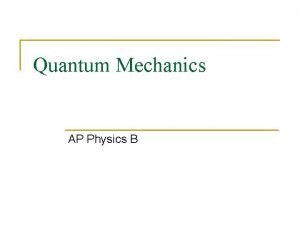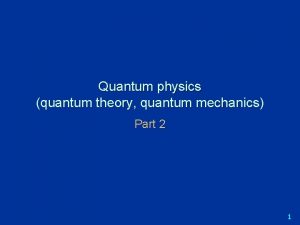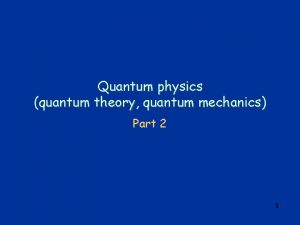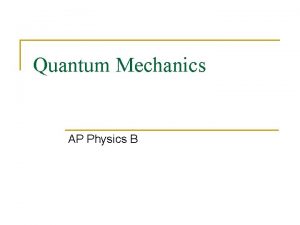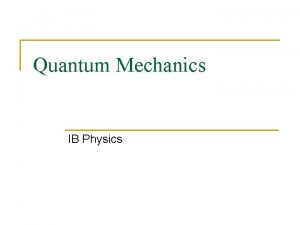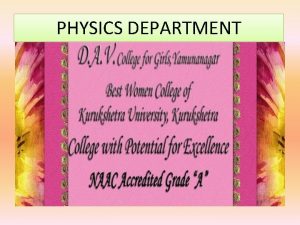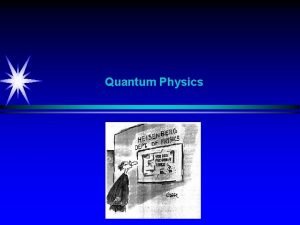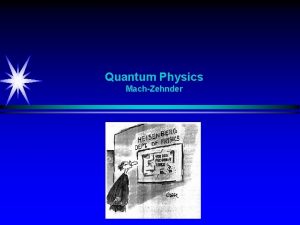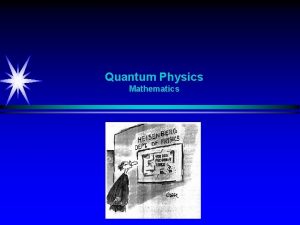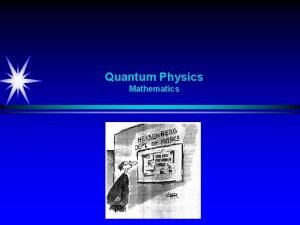Whitehead James and Quantum Physics Whiteheads Process Ontology








![The Atomization of Space-Time • “The actual entities atomize the extensive continuum. This [space-time] The Atomization of Space-Time • “The actual entities atomize the extensive continuum. This [space-time]](https://slidetodoc.com/presentation_image/aab5862630539ae502eec7d84849f7ce/image-9.jpg)

























- Slides: 34

Whitehead, James, and Quantum Physics Whitehead’s Process Ontology as a Framework for a Heisenberg/James/von Neumann Conception of Nature and of Human Nature

Incorporating consciousness into physics. • Whitehead’s “Process” Conception of Nature allows consciousness to be injected into physical theory. • My plan is to: (1), identify the key elements of Whitehead’s ontology: (2), put them coherently together; (3), do the same for quantum theory; (4) amalgamate the two conceptions into a single theory that is better defined than either one alone; and finally (5), to give a simple but important application. • Ambiguities in either theory alone are resolved by requiring the two theories to reduce coherently to one.

Whitehead’s First Principle: The World is Built Out Of “Actual Entities”! • “ ‘Actual entities’---also termed ‘actual occasions’, are the final real things of which the world is made. ” (PR, p. 18) • “The final facts are, all alike, actual entities, and these actual entities are drops of experience, complex and interdependent. ” (p. 18)

Whitehead accepts James’s claim about the droplike (atomic/indivisible) character of experience • “Either your experience is of no content, of no change, or it is of a perceptible amount of content or change. Your acquaintance with reality grows literally by buds or drops of perception. Intellectually and on reflection you can divide them into components, but as immediately given they come totally or not at all. ” (Wm. James, Po. P, Vol 1, p. 68)

“Thought is Itself the Thinker” • If the passing thought be the directly verifiable existent, which no school has hitherto doubted it to be, then that thought is itself the thinker, and psychology need not look beyond. (Po. P, Vol 1, p. 401) • Thus the “actual entities” are the “drops of experience” themselves, not the conscious thinkers that know them, • Your awareness of your “self” must be an aspect of your thoughts: there is no need for, additionally, a persisting conscious “self” standing behind your thoughts. • Your stream of consciousness consists of “ideas clinging together”---”whence do they get their fantastic laws of clinging? ” (Vol 1, p. 3)

A Basic Whiteheadian Distinction: “Continuous Potentialities” versus “Atomic Actualities” • “continuity concerns what is potential, whereas • actuality is incurably atomic. ” (PR, p. 61)

Actual Entities Decide Things • “Actual entities … make real what was antecedently merely potential. ” (p. 72) • “every decision is referred to one or more actual entities…Actuality is decision amid potentiality. ” (p. 43). • “Actual entities are the only reasons. ” (p. 24)

Each (Temporal) Actual Entity is associated with a Region of Space. • “every actual entity in the temporal world is to be credited with a spatial volume for its perspective standpoint. . . ” (p. 68)
![The Atomization of SpaceTime The actual entities atomize the extensive continuum This spacetime The Atomization of Space-Time • “The actual entities atomize the extensive continuum. This [space-time]](https://slidetodoc.com/presentation_image/aab5862630539ae502eec7d84849f7ce/image-9.jpg)
The Atomization of Space-Time • “The actual entities atomize the extensive continuum. This [space-time] continuum is in itself merely potentiality for division. ” p. 67 • “The contemporary world is in fact divided and atomic, being a multiplicity of definite actual entities. These contemporary actual entities are divided from each other, and are not themselves divisible into other contemporary actual entities” p. 62

Growing Actuality Is Created in a Growing Actual Space-Time Whitehead’s actuality consists of a growing sequence of actual entities. • The basic process of nature creates an atomized actual space-time from a prior continuous potential space-time. • Nature’s process assigns a separate space-time region to each actual entity. • Nature’s process fills up, step-by-step, the space -time region lying in the past of the advancing sequence of space-like surface “now”.

Time Open Future Fixed Past

“Receptacle” versus “Relational” Conception of Space-Time • Newton’s “receptacle” space and time exists even if nothing is in it. • Leibniz’s relational view. Space-time pertains to relations among actually existing entities: Empty space is a nonsensical idea. • Whitehead: Atomized actual space-time is occupied by actual atomic (indivisible) entities, and is created out of continuous potentiality for space-time

Contrast with the Growing “Past” in Non-Relativistic Physics • In non-relativistic physics the growing “past” lies behind an advancing (into the future) sequence of constant-time instants “now”.

Non-Relativistic Instants “Now” Open Future Time n+3 n+2 n+1 n Fixed Past Open Future

From Von Neumann NRQT to Tomonaga-Schwinger RQFT. • The NR quantum state Ψ(t) Ψ(σ) • t specifies a continuous three-dimensional surface in the four-dimensional space-time continuum, with all spatial points lying at the same time t. • σ specifies a continuous three-dimensional surface in the four-dimensional space-time continuum, with every point on the surface spacelike-like separated from every other point.

Time Open Future Fixed Past

“Objective Potentia” and “Subjective Knowledge” in Quantum Theory • Heisenberg: “The probability function combines objective and subjective elements. It contains statements about possibilities or better tendencies (“potentia” in Aristotelian philosophy) and these are completely objective, …and it contains statements about our knowledge of the system, which of course are subjective in so far as they may be different for different observers. ” (P&P, p. 53)

Transition from “Potentiality” to “Actuality” in Quantum Mechanics • Heisenberg: “the transition from the ‘possible’ to the ‘actual’ takes place during the act of observation. ” • Heisenberg: “The observation itself changes the probability function discontinuously; it selects of all possible events the actual one that has taken place. Since through the observation our knowledge of the system has changed discontinuously, its mathematical representation has also undergone the discontinuous change and we may speak of a ‘quantum jump’ ” (P&P, p. 54)

Time Open Future Fixed Past

Compatible with Einstein’s (Special) Theory of Relativity • All predictions are independent of the sequential ordering of space-like separated events. • No “signal” (controlled message) can be transmitted faster than the velocity of light.

Psycho-Physical Building Blocks • In this Whiteheadian ontologicalization of quantum theory, each quantum reduction event is identified with a Whiteheadian actual entity/occasion! • Each Whiteheadian actual occasion/entity has a “mental pole” and a “physical pole”. • Each Heisenberg quantum reduction event specifies an increment in (experienced) knowledge, and an associated reduction of the physical state of the universe to one compatible with the new state of knowledge.

Basic Ontology: A Summary • Objective/absolute actuality consist of a sequence of psycho-physical quantum reduction events, identified as Whiteheadian actual entities/occasions. • These happenings combine to form/create a growing “past” of fixed and settled “facts”. • Each “fact” is associated with (1), a fixed space-time region; (2), the actualization of some subset of the potentialities created by the set of prior events; (3), a “drop of experience” that constitutes “new knowledge”; and (4), the eradication of all of the potentialities that conflict with the new knowledge.

Continuity and Causation in Classical Physics • Classical physics postulates a continuous process satisfying “causal closure of the physical”: the physical description, by itself, provides for a causally complete deterministic account. No effects of mind or consciousness on the physically described properties need be introduced or acknowledged. • Thus, according to the classical conceptualization, Mind/Consciousness is redundant or epiphenomenal: it adds no causal input to the already complete causal structure.

But Orthodox Quantum Theory has Two Causal Gaps. The determinations of two kinds of under-determined decisions are needed to make quantum theory work! • “Free choices” by conscious agents. Basically, these are choices to act in a particular way with an intent to elicit a specific conceived experiential feedback. • These choices made by agents are not determined within orthodox theory---either statistically or otherwise. • But the intended feedback/outcome may or may not actually occur. • The quantum state of the universe just prior to the agent’s choice determines the probability for the intended feedback to occur. It does not determine whether---or not---that feedback will occur.

Filling the Causal Gap. • Orthodox Quantum Theory does not determine what we decide to do. • These choices of actions are, within that theory, “free choices”. • The Whitehead Quantum ontology provides a rational conceptual framework for approaching this basic issue that contemporary quantum theory leaves unresolved: How are our choices about how we will act generated; and how are they implemented ?

Significance • The mainstream neuroscience “materialist” assumption is that “any effect of mind is causally reducible to the physically describable aspects of nature”. • This presumption neither demanded nor supported by orthodox physical theory • Mind can in principle enter fundamentally into brain dynamics in an essential and non-eliminable way.

Whiteheadian Process “The many become one, and are increased by one. ” (PR p. 21) • The past actualities combine to determine a new space-time standpoint (region) from which the potentialities created by the past actualities will be prehended (grasped). • The von Neumann/Tomonaga/Schwinger quantum state restricted to that region represents the physically describable potentialities available to the associated entity. • But the effects of the mental poles of past occasions can also intrude into the process.

Actual Occasions of the First Kind • An Actual Occasion of the first kind chooses an intended action: it initiates an action that will tend to produce an intended experiential feedback. • It actualizes its neural correlate, which is a “template for action”: a macroscopic pattern of physical (neurological) activity which, if sustained for a sufficiently long time, will tend to cause the intended feedback to occur. • Synchronous macroscopic gamma-band activity is the prime candidate for a “template for action”.

Actual Occasions of the Second Kind • An Actual Occasion of the second kind specifies which one of the mutually exclusive alternative possible feedbacks actually occurs. • Occasions of the first and second kind have been called, respectively, “choices on the part of the experimenter” and “choices on the part of nature” (Bohr, !958, p. 51)

Simplest Application • Suppose the idea “I shall now raise my arm” occurs, and this experience is colored by a strong feeling of the positive value of that contemplated action. • Suppose this experience tends to produce a successor in which the core idea “I shall now raise my arm” is colored with a feeling of “effort to raise now my arm”

Simplest Application Continued • Suppose that experience causes, by virtue of the “fantastic laws of clinging” an immediate (within a few milliseconds) repetition of that experience, and that this causes another immediate repetition, and so on. • This rapid sequence of actualizations of the associated “template for action” will tend---by virtue of the so-called quantum Zeno effect---to hold that template for action in place for longer than would otherwise be the case.

Simplest Application Continued • This persisting excitation of the template for action will tend to cause your arm to rise. • Every cause connection used here is strictly compatible with the orthodox laws of physics: a certain causal gap in that theory has merely been filled in a particular way. • The quantum Zeno effect is itself a decoherence effect, and it is not diminished by environmental decoherence. • Thus a simple physical effect of a conscious intent and effort is explained within a causal framework that amalgamates orthodox quantum theory and Whiteheadian process.

Benefits • Actual scientific practice has three components: (1), our freedom to act upon the world in ways of our choosing; (2), the experienced feedbacks from these actions; and (3) a mathematical framework used to explain the connections between the first two. • The proposed ontology treats the three components as bona fide aspects of a psychophysical whole, rather than trying to force theory into an essentially classical-physics-type consciousness-free mold.

Benefits Continued • In dealing with empirically occurring correlations between our choices of how we will act and the experienced consequences of these acts, it is difficult and awkward to use a theory that denies the freedom of these choices, and that cannot explain the occurrence of any experience of any kind. • Contemporary physical theory is not unnaturally constrained in the way that classical physical theory was, and it hobbles the development of science to shackle it in the old ways.
 Quantum physics vs mechanics
Quantum physics vs mechanics Quantum physics vs mechanics
Quantum physics vs mechanics Dahlgren whitehead 1991
Dahlgren whitehead 1991 Good places better health
Good places better health Quantum and nuclear physics
Quantum and nuclear physics Curriculum mapping template
Curriculum mapping template Dahlgren whitehead model
Dahlgren whitehead model Graham whitehead health
Graham whitehead health Derrick whitehead
Derrick whitehead Affix pronunciation
Affix pronunciation Charles k whitehead
Charles k whitehead Dahlgren whitehead
Dahlgren whitehead Dahlgren whitehead
Dahlgren whitehead Dahlgren e whitehead
Dahlgren e whitehead Dahlgren e whitehead
Dahlgren e whitehead Dahlgren whitehead model
Dahlgren whitehead model James russell odom and james clayton lawson
James russell odom and james clayton lawson Russell odom and clay lawson
Russell odom and clay lawson Quantum physics wave function
Quantum physics wave function Diode khan academy
Diode khan academy Beta plus decay
Beta plus decay Quantum physics wave function
Quantum physics wave function Finite potential well
Finite potential well Physics topic 12
Physics topic 12 Quantum physics summary
Quantum physics summary Electron volt to volt
Electron volt to volt Quantum physics in hindi
Quantum physics in hindi Ontological vs epistemological
Ontological vs epistemological What is epistemology in research
What is epistemology in research Ontology epistemology and axiology
Ontology epistemology and axiology What is an ontologist
What is an ontologist Suggested upper merged ontology
Suggested upper merged ontology Napolen pizza
Napolen pizza Ontology vs epistemology
Ontology vs epistemology Ontology alignment
Ontology alignment


